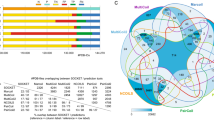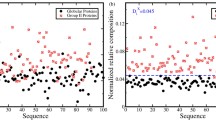Abstract
Surface accessibility of different types of the same elements of secondary structure has been studied in 10 non-redundant sets of proteins (total number of three-dimensional structures is 1730) with a help of DSSP (Dictionary of Secondary Structure of Proteins). Random coils (C), beta strands (B), and alpha helices (H) have been classified according to their flanking elements of secondary structure in a polypeptide chain. Thanks to this kind of classification, for the first time it has been shown that random coils situated between a beta strand and an alpha helix (BCH) contain significantly lower fraction of exposed residues compared to other types of random coils; the least accessible beta strands are situated between two alpha helices (HBH), and the least accessible alpha helices are situated between a beta strand and an alpha helix (BHH). Discovered trends are explained as consequences of the natural selection that had been stabilizing the secondary structure of proteins on early steps of their evolution. Acquired differences in amino acid content of different types of random coils, alpha helices, and beta strands led to the formation of partially buried but hydrophilic BCH random coils because of their enrichment by Ser, Thr, and Asp residues. As a result, BCH random coils became prone to bind cations because of their lower hydration and decreased usage of positively charged amino acid residues. The mechanism described above led to the formation of active centers in ancient metalloenzymes. Nowadays one can observe decreased surface accessibility of amino acid residues in BCH random coils, in HBH beta strands, and in BHH alpha helices in proteins possessing hydrophobic cores.





Similar content being viewed by others
References
Lee B, Richards FM (1971) The interpretation of protein structures: estimation of static accessibility. J Mol Biol 55:379–400
Kabsch W, Sander C (1983) Dictionary of protein secondary structure: pattern recognition of hydrogen-bonded and geometrical features. Biopolymers 22:2577–2637
Shrake A, Rupley JA (1973) Environment and exposure to solvent of protein atoms. Lysozyme and insulin. J Mol Biol 79:351–371
Richmond TJ, Richards FM (1978) Packing of alpha-helices: geometrical constraints and contact areas. J Mol Biol 119:537–555
Ahmad S, Gromiha M, Fawareh H, Sarai A (2004) ASAView: database and tool for solvent accessibility representation in proteins. BMC Bioinform 5:51
Khrustalev VV, Poboinev VV, Stojarov AN, Khrustaleva TA (2019) Microenvironment of tryptophan residues in proteins of four structural classes: applications for fluorescence and circular dichroism spectroscopy. Eur Biophys J 48:523–537
Liou YF, Huang HL, Ho SY (2016) A hydrophobic spine stabilizes a surface-exposed α-helix according to analysis of the solvent-accessible surface area. BMC Bioinform 17:503
Moret MA, Zebende GF (2007) Amino acid hydrophobicity and accessible surface area. Phys Rev E Stat Nonlin Soft Matter Phys 75:011920
Lins L, Thomas A, Brasseur R (2003) Analysis of accessible surface of residues in proteins. Protein Sci 12:1406–1417
Durham E, Dorr B, Woetzel N, Staritzbichler R, Meiler J (2009) Solvent accessible surface area approximations for rapid and accurate protein structure prediction. J Mol Model 15:1093–1108
Khrustalev VV, Khrustaleva TA, Barkovsky EV (2013) Random coil structures in bacterial proteins. Relationships of their amino acid compositions to flanking structures and corresponding genic base compositions. Biochimie 95:1745–1754
Khrustalev VV, Khrustaleva TA, Poboinev VV (2018) Amino acid content of beta strands and alpha helices depends on their flanking secondary structure elements. Biosystems 168:45–54
Saunders R, Mann M, Deane CM (2011) Signatures of co-translational folding. Biotechnol J 6:742–751
Florens L, Schmidt B, McCracken J, Ferguson-Miller S (2001) Fast deuterium access to the buried magnesium/manganese site in cytochrome c oxidase. Biochemistry 40:7491–7497
Khrustalev VV, Khrustaleva TA, Poboinev VV, Karchevskaya CI, Shablovskaya EA, Terechova TG (2019) Cobalt(ii) cation binding by proteins. Metallomics 11:1743–1752
DeForte S, Uversky VN (2016) Resolving the ambiguity: making sense of intrinsic disorder when PDB structures disagree. Protein Sci 25:676–688
Basu S, Bahadur RP (2020) Do sequence neighbours of intrinsically disordered regions promote structural flexibility in intrinsically disordered proteins? J Struct Biol 209:107428
Aurora R, Rose GD (1998) Helix capping. Protein Sci 7:21–38
Nilofer C, Sukhwal A, Mohanapriya A, Kangueane P (2017) Protein-protein interfaces are vdW dominant with selective H-bonds and (or) electrostatics towards broad functional specificity. Bioinformation 13:164–173
Hadi-Alijanvand H (2019) Soft regions of protein surface are potent for stable dimer formation. J Biomol Struct Dyn 12:1–12
Sueoka N (1988) Directional mutation pressure and neutral molecular evolution. Proc Natl Acad Sci USA 85:2653–2657
Du MZ, Zhang C, Wang H, Liu S, Wei W, Guo FB (2018) The GC content as a main factor shaping the amino acid usage during bacterial evolution process. Front Microbiol 9:2948
Lobry JR (1997) Influence of genomic G+C content on average amino-acid composition of proteins from 59 bacterial species. Gene 205:309–316
Singer GA, Hickey DA (2000) Nucleotide bias causes a genomewide bias in the amino acid composition of proteins. Mol Biol Evol 17:1581–1588
Khrustalev VV, Barkovsky EV (2012) A blueprint for a mutationist theory of replicative strand asymmetries formation. Curr Genomics 13:55–64
Khrustalev VV, Khrustaleva TA, Poboinev VV, Yurchenko KV (2019) Mutational pressure and natural selection in epidermal growth factor receptor gene during germline and somatic mutagenesis in cancer cells. Mutat Res 815:1–9
Khrustalev VV, Barkovsky EV (2012) Stabilization of secondary structure elements by specific combinations of hydrophilic and hydrophobic amino acid residues is more important for proteins encoded by GC-poor genes. Biochimie 94:2706–2715
Moutinho AF, Trancoso FF, Dutheil JY (2019) The impact of protein architecture on adaptive evolution. Mol Biol Evol 36:2013–2028
Khrustalev VV, Barkovsky EV (2011) Percent of highly immunogenic amino acid residues forming B-cell epitopes is higher in homologous proteins encoded by GC-rich genes. J Theor Biol 282:71–79
Banerjee T, Gupta SK, Ghosh TC (2005) Role of mutational bias and natural selection on genome-wide nucleotide bias in prokaryotic organisms. Biosystems 81:11–18
Oda A, Nakayoshi T, Kato K, Fukuyoshi S, Kurimoto E (2019) Three dimensional structures of putative, primitive proteins to investigate the origin of homochirality. Sci Rep 9:11594
Higgs PG, Lehman N (2015) The RNA World: molecular cooperation at the origins of life. Nat Rev Genet 16:7–17
Weinberg CE, Weinberg Z, Hammann C (2019) Novel ribozymes: discovery, catalytic mechanisms, and the quest to understand biological function. Nucleic Acids Res 47:9480–9494
Acknowledgement
The author would like to thank Professor A.N. Stojarov, the head of the department of Radiation Medicine and Ecology of Belarusian State Medical University for the encouragement to perform this study.
Author information
Authors and Affiliations
Corresponding author
Additional information
Publisher's Note
Springer Nature remains neutral with regard to jurisdictional claims in published maps and institutional affiliations.
Rights and permissions
About this article
Cite this article
Khrustalev, V.V. Random Coils of Proteins Situated Between a Beta Strand and an Alpha Helix Demonstrate Decreased Solvent Accessibility. Protein J 39, 308–317 (2020). https://doi.org/10.1007/s10930-020-09905-0
Published:
Issue Date:
DOI: https://doi.org/10.1007/s10930-020-09905-0




